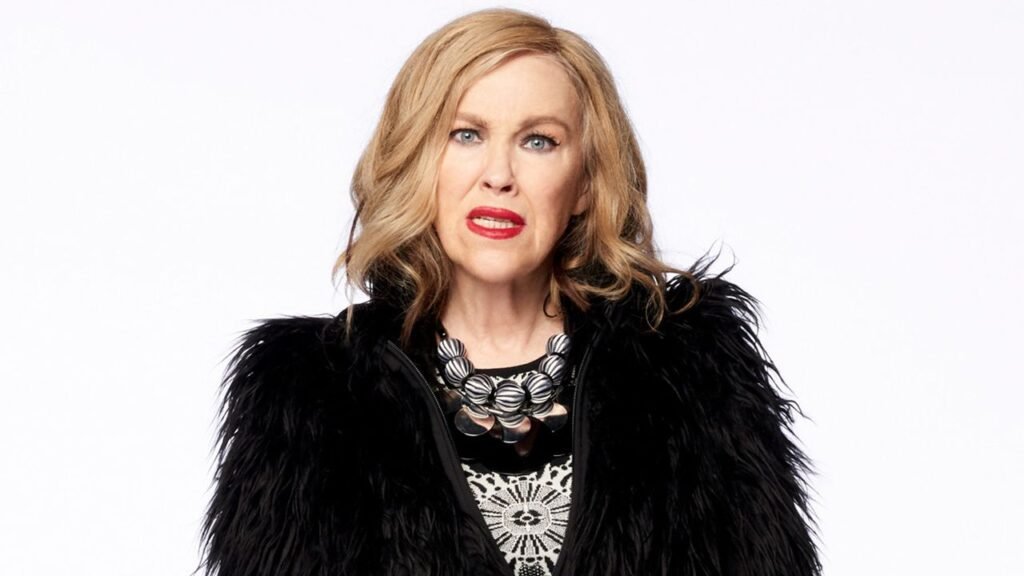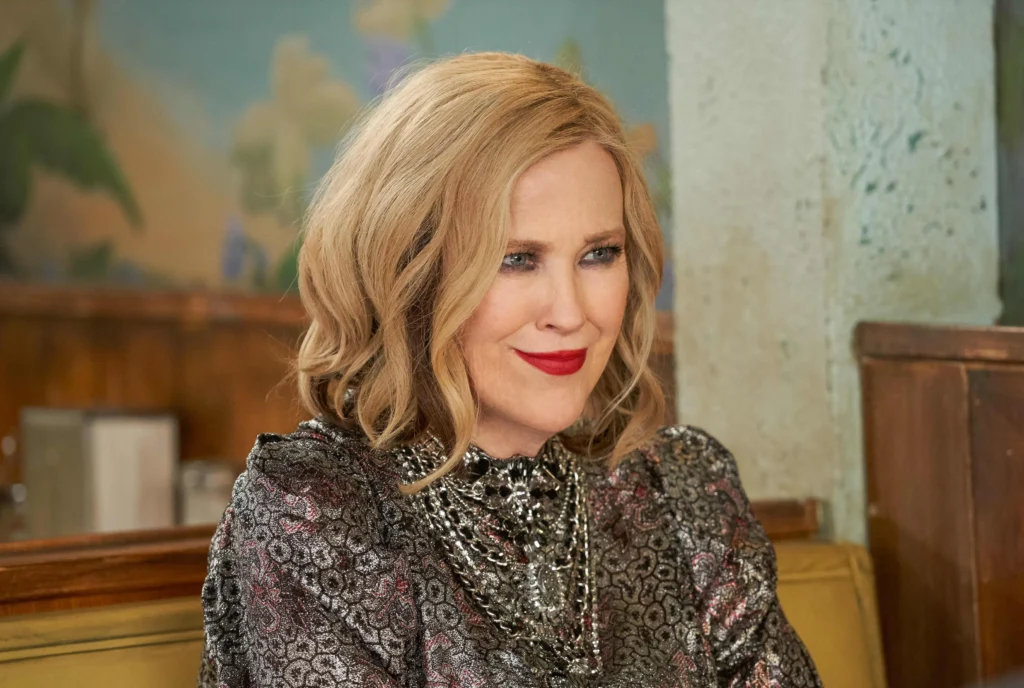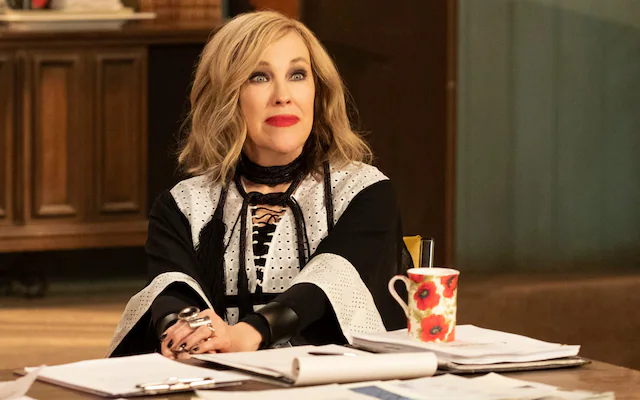There are TV characters who entertain, and then there are characters who reshape culture. moira rose arrived on screens as a glamorous, self-absorbed former soap star whose fall from luxury seemed destined for mockery. Instead, she became something far more surprising: a comedic revelation, a style icon, and a character who spoke to millions with her strange elegance and accidental heart.
Part diva, part philosopher, Moira blended theatrical absurdity with emotional vulnerability so seamlessly that audiences couldn’t look away. Her exaggerated vocabulary, unpredictable wigs, and larger-than-life presence shouldn’t have worked — yet they did, transforming her into one of television’s most unlikely modern legends.
Here’s everything to know about how moira rose became the unexpected TV icon who captivated the world.
Quick Bio Table
| Fact | Details |
|---|---|
| Full Name | Moira Rose |
| First Appearance | Schitt’s Creek (Season 1, 2015) |
| Last Appearance | Series Finale (2020) |
| Portrayed By | Catherine O’Hara |
| Occupation | Actress, former socialite, town councillor |
| Known For | Playing Vivian Blake on Sunrise Bay |
| Spouse | Johnny Rose |
| Children | David Rose, Alexis Rose |
| Nationality (in-universe) | American/Canadian (unconfirmed) |
| Personality Type | Dramatic, eccentric, emotionally guarded |
| Signature Style | Black-and-white couture and iconic wigs |
| Cultural Impact | Meme icon, fashion inspiration, fan-favorite character |
| Series Setting | Town of Schitt’s Creek |
How did moira rose become such an unforgettable television presence?

Moira was introduced as an exaggerated caricature — a woman so ensconced in wealth and delusion that she could barely function without haute couture and a full wall of wigs. Yet it didn’t take long for audiences to realize there was much more beneath her dramatic surface.
Her comedic rhythm, shaped by Catherine O’Hara’s impeccable instincts, gave the character a kind of musicality. Every line felt curated, theatrical, and slightly unpredictable, turning even mundane moments into comedic set pieces. She wasn’t written to blend in — she was written to dominate the frame — and she did so with striking originality.
But more importantly, Moira’s journey wasn’t static. Her emotional evolution, slow and subtle, revealed a woman who had spent years protecting herself with performance — and was finally learning to connect without the armor.
What shaped moira rose before the world met her?
In the show’s backstory, Moira began far from the glittering lifestyle she later adopted. She reportedly grew up in a modest town, working thankless jobs before fate intervened. Her break came unexpectedly: she was discovered by a director while working a shift at a gas-station deli. That chance encounter launched her into the world of theater, where she first played Sally Bowles in Cabaret.
From that moment, Moira curated her life with meticulous flair. She embraced eccentricity, rejected the ordinary, and constructed a persona that blended European mystique with old-Hollywood glamour. Her marriage to Johnny Rose only elevated her world further, placing her firmly in the upper tier of celebrity society.
For years, she lived as though the universe revolved around her schedule, her press interviews, and her dramatic return arcs on Sunrise Bay. But the financial collapse that sent the Roses to Schitt’s Creek forced Moira to confront a life stripped of privilege — something she had never imagined.
How did moira rose adapt to life in Schitt’s Creek?
Moira arrived in the small town like a queen exiled from her palace. Her couture wardrobe made no sense in a rural motel, she refused to engage with the locals, and she viewed every inconvenience as a personal attack. Her detachment was part self-preservation and part denial.
But as the series unfolded, Moira’s edges softened in ways viewers didn’t expect.
She joined the town council — reluctantly at first — and discovered a capacity for civic engagement that surprised her as much as anyone else. Her vocal coaching for the Jazzagals, the local women’s singing group, showcased her theatrical generosity. And her friendships, particularly with Jocelyn Schitt, revealed a tenderness and odd humility beneath the dramatic exterior.
More importantly, Moira relearned how to be a mother. She had spent years distant from her children’s emotional lives, but Schitt’s Creek brought her into closer, more intimate moments with David and Alexis. Those scenes often held some of the show’s most touching truths, delivered in Moira’s unmistakable voice but grounded in genuine love.
Why is moira rose’s fashion considered legendary?
Moira’s wardrobe became a character of its own. She favored bold, architectural silhouettes, monochromatic palettes, and exaggerated accessories. Every outfit felt intentional, symbolic, and meticulously chosen — a visual declaration that she refused to blend into the mundane world around her.
Her curated black-and-white aesthetic served multiple purposes:
It was armor.
It was identity.
It was performance.
But nothing defined her visual style more than her wigs. Displayed proudly like treasured artifacts, the wigs were named, categorized, and emotionally loaded. Choosing a wig was choosing a persona — a quiet insight into her mood, her fears, or her illusions of control.
Fashion journalists often cite Moira as one of TV’s most distinct sartorial characters, placing her alongside icons like Carrie Bradshaw and Alexis Carrington. Yet unlike those characters, Moira’s style wasn’t simply glamorous — it was theatrical, artistic, and intentionally out of place. That dissonance became part of her charm.
How did her acting career shape the character’s identity?
Moira’s on-screen persona was defined by her long-running role as Vivian Blake in the fictional soap opera Sunrise Bay. She spoke of Vivian with both pride and resentment — admiring the fame but bemoaning the melodrama. Her past as a soap star influenced her speech, her mannerisms, and her exaggerated emotional responses.
Even in Schitt’s Creek, she clung to her identity as a performer. When given the chance to return to the industry, she treated it as a revival of her former glory. Whether it was starring in a low-budget horror film or navigating a potential reboot of Sunrise Bay, Moira approached every opportunity like a Shakespearean challenge.
Her relationship to acting was complicated. It was her escape, her validation, and her self-constructed legend. But it was also her cage — a role she played for so long that she forgot how to exist without an audience.
Her rediscovery of that passion became one of the show’s most fulfilling arcs.
What made moira rose unexpectedly relatable?
Moira’s eccentricities were extreme, but her emotional truths were universal.
She feared irrelevance.
She clung to identity when the world shifted.
She used humor and performance to mask vulnerability.
She struggled to connect but yearned for love.
Underneath the feathers, sequins, and theatrical vocabulary, Moira was a woman trying to rebuild her life after losing everything that once defined her. Viewers saw themselves in that struggle — not the wealth or couture, but the fear of change and the courage required to face it.
Her transformation wasn’t about becoming someone new. It was about finally letting herself be seen.
How did moira rose influence modern pop culture?

Few characters from the past decade have inspired such devotion. Fans create Moira-inspired Halloween costumes, analyze her wardrobe, remix her quotes, and celebrate her linguistic quirks on social platforms. Her vocabulary, filled with ornate, vaguely European flourishes, became a cultural phenomenon.
Her accent — a hybrid of Transatlantic glamour and Moira-specific musicality — captivated audiences and inspired countless parodies and homages. But beneath the humor, critics praised Moira as a masterclass in character creation.
She symbolized reinvention, resilience, and unapologetic individuality.
Moira wasn’t designed to be lovable — but she became beloved.
Conclusion
Moira Rose began as an extravagant caricature but ended as one of the most compelling characters of the decade. Her blend of theatrical absurdity, emotional honesty, and unapologetic individuality created a persona that felt both larger than life and profoundly human.
She taught audiences that reinvention is possible at any age, that vulnerability can exist beneath even the most dramatic exterior, and that sometimes the boldest expressions of self are the ones that resonate most deeply.
It is precisely this mix of humor, heart, and fearless style that transformed moira rose into an unexpected TV icon — one who continues to captivate the world long after her final scene.
FAQ: Frequently Asked Questions about moira rose
1. Is moira rose a real person?
No. Moira is a fictional character from the series Schitt’s Creek, portrayed by Catherine O’Hara.
2. What is moira rose best known for in the show?
She is best known for her dramatic personality, couture fashion, iconic wigs, and her role as Vivian Blake on the soap opera Sunrise Bay.
3. Why does moira rose speak with such a strange accent?
Her accent is intentionally theatrical — a blend of old-Hollywood Transatlantic style and Moira’s own cultivated eccentricity.
4. Did moira rose really grow up wealthy?
No. In the show’s lore, she reportedly grew up modestly before reinventing herself as a celebrity.
5. Why did moira rose gain such a huge fan following?
Her unique personality, impeccable comedic timing, emotional depth, and unforgettable style created a character unlike anything else on modern television.
